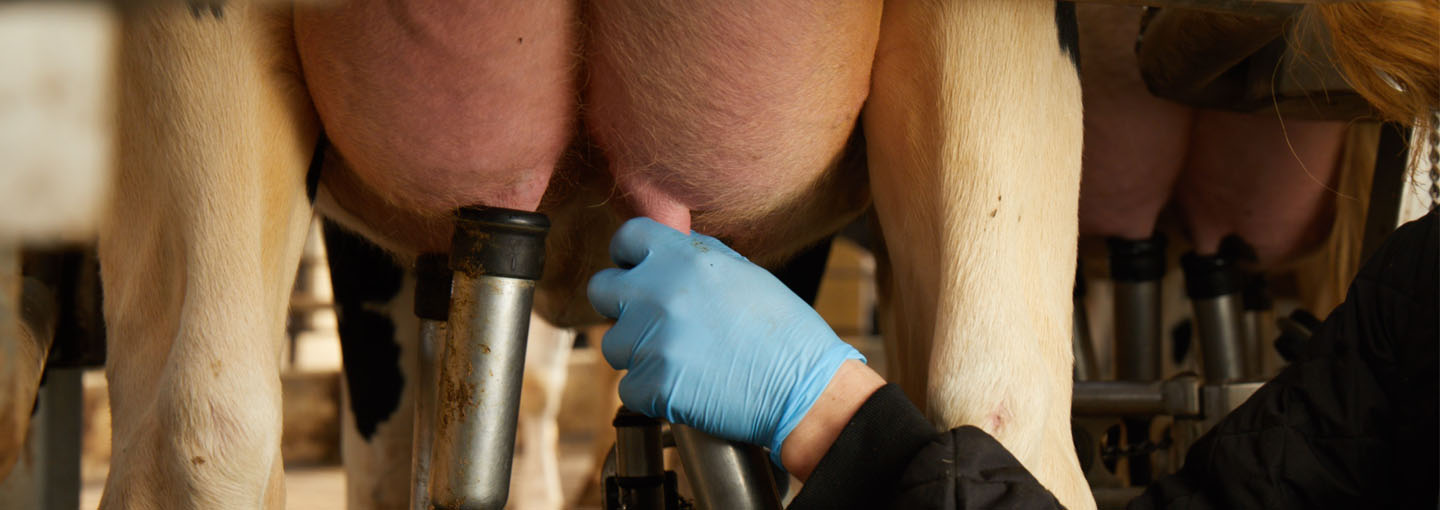
Milking routines in dairy herds - best practice
Optimal milking routines are crucial for both good udder health and good milk quality. Read about how to achieve best practice milking routines.

Optimal milking routines are crucial for both good udder health and good milk quality. Read about how to achieve best practice milking routines.
Poor or incorrect milking routines affect animal welfare, increase the risk of mastitis and can reduce yield. In other words, there is good reason to ensure best practice routines in the milking parlor and to make sure that every milker knows these routines.
The purpose of the milking procedures is:
Good milking requires good preparation of the cow to ensure that it lets down the milk. Therefore, the first step of the milking process is to stimulate the cow’s udder to activate the milk letdown. The milk letdown is a physiological process that happens naturally in a cow when her calf seeks her out to suck. When the calf stimulates the cow to let down her milk, visual as well as sense impressions are evoked. This process is imitated when the cow is prepared.
When the cow’s udder is stimulated by contact (by drying off and forestripping), the muscles surrounding the lactiferous ducts, the cistern and teat canal are relaxed to make room for the actual milk letdown. The pituitary gland releases the milking hormone oxytocin which is transported with the blood to the milk cells. The oxytocin makes the alveoles squeeze together (the little cavities in the mammary tissue), which pushes the milk into the lactiferous ducts (see figure).

Figure: During preparation, the cow’s udder is stimulated so that a signal is sent via a neural impulse to the pituitary gland in the cow’s brain. The pituitary gland then releases the hormone oxytocin which is transported with the blood to the udder cells which then contract and push the milk into the lactiferous ducts. This is synonymous with the cow letting the milk down.
It takes between 30-60 seconds from the cow’s release of oxytocin until the actual milk letdown. In herds with 2 daily milkings, it must not take more or less than 60 to 90 seconds from the preparation of the cows until the attachment of the milking set. With 3 daily milkings, it must not take more than 90 to 120 seconds. Handling the cows calmly and preparing well at every milking will cause the cows to relax when they arrive for milking and they will almost automatically start to let down the milk when arriving in the milking parlor. This contributes to a faster milking and a proper milk out.
When the milking starts, the udder cistern will always contain a little milk – typically 1-2 liters which can be milked directly. Therefore, it is important that the cow is properly prepared and lets down the milk so that there are no breaks in the milk flow. This ensures that the letdown of the actual quantity of milk follows next without overmilking. Specifically, the overmilking, or bimodal milk flow, is one of the main reasons for injuries to the teats and the udder, which may result in mastitis and are caused by poor milking skills.
Stress in cows may inhibit and reduce the production of oxytocin, thus complicating an efficient emptying of the udder. If the cow is suddenly stressed, adrenaline is released into the blood. This reduces the blood flow to the udder by 95% and hinders the oxytocin in reaching the milk cells. In other words, a stressed cow does not let down the milk.
A normal milking is not possible until 15 minutes after the release of adrenaline. If the cow becomes stressed multiple times during milking, for example because of disturbance during milking and poor routines, a permanent yield reduction in the cows in question is risked.
After wiping, attach the milking set, letting only a minimum of air into the pipe. Extra air increases the risk of contaminating the milk. Also, if air gets mixed up with the milk, it may destroy the milk fat globule membrane, thus increasing the amount of FFA and the risk of a shorter shelf life for the milk.
After attaching the milking set, the pipe is adjusted so that the machine is placed correctly under the udder. There must be no dirt on the outside of the machine.
After the milking, the cows must be post-dipped. When the milking set is detached, the teat canals are wide open, and it takes a minimum of 10-15 minutes until they are completely closed again. During this time, the udder is especially susceptible to the entry of damaging bacteria. By dipping the teats in a disinfectant, this risk is reduced. Apart from the disinfectant, the teat dipping typically includes care products such as glycerin which helps strengthen and comforting the skin of the udder and makes it softer.
Make sure that the whole teat is covered with the post-dip product. Although the space between the rear teats is very small, they must not be dipped at the same time. Dip one teat at a time.
Systems with automatic milking (milking robots) prepare the cow and clean the teats automatically before the teat cups are attached. The various milking robot manufacturers have developed different kinds of equipment for this purpose. These include cleaning cups which stimulate and clean the teats at the same time, or rotating brushes that also stimulate and clean the teats.
The challenges of the milking process are identical with those of conventional milking. Therefore, it is important to respect the time intervals mentioned above to obtain an even letdown of milk without overmilking. As to that, the different brands have their own setting ranges.
Emneord
